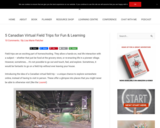
The virtual field trips on this site include:
The Parliament Buildings in Ottawa, Ontario
Iqaluit, Nunavut – The Canadian Arctic
Farm Tours
Canadian Museum of History
The Royal Tyrrell Museum

The virtual field trips on this site include:
The Parliament Buildings in Ottawa, Ontario
Iqaluit, Nunavut – The Canadian Arctic
Farm Tours
Canadian Museum of History
The Royal Tyrrell Museum

Curate your own exhibition at the Art Gallery of Ontario; swim with African penguins at the San Diego Zoo; travel back in time at the Louvre; visit the Canadian Museum of History; blast into outer space with NASA. This site offers all of these opportunities for your student to experience.
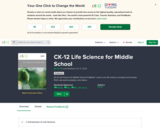
CK-12 Life Science for Middle School FlexBook® covers core life science concepts and includes real world examples, videos, and PLIX (which stands for Play, Learn, Interact, and eXplore—offers learners an interactive and immersive experience exploring concepts).
ck12.org
This is an extremely comprehensive unit on Diversity and Living Things. Some of the chapters are not aligned directly with grade 6 outcomes, but have the potential to be used for enrichment activities. In addition to what is listed above, this resource also includes online practice quizzes for students. Teachers can download printable versions of the quizzes, along with an answer key.
*You will have to sign up to ck12.org to access everything, but it is completely free!

In this interactive online activity, you will explore the Canadian Arctic, the history of the Northwest Passage and the importance of maintaining a strong Canadian presence in the northern region.
Questions:
1. Identify four unique characteristics of the Canadian Arctic region.
2. Identify contributions made by some of the Arctic explorers who searched for the Northwest Passage.
3. To what extent did the Inuit culture in the Canadian Arctic help with the discovery of one of Franklin's lost ships?
4. What impact would climate change and the opening of the Northwest Passage have on the Inuit people socially, environmentally, and economically?
5. How might the opening of the Northwest Passage affect Canada’s claim to Arctic sovereignty and its relationship with other countries?
6. What are some of the ways Canada is getting involved in protecting the Arctic?

Canadian Geographic Education provides learning resources to help improve students’ understanding of the world they live in. Geographically literate students are better prepared to face global challenges and have the skills necessary to become effective change agents. Use these resources to inspire curiosity and exploration in your classroom!
Lesson plans
Videos
Maps
Infographics
Activities
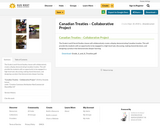
The Grade 6 and 8 Social Studies classes will collaboratively create a display
demonstrating Canadian treaties. This will provide the students with an
opportunity to be engaged in a high-level task, discussing, making shared
decisions, and designing a product that demonstrates deeper learning.

An inquiry-based project to map the land in your community. The key concepts in this unit are grounded in Indigenous beliefs of interconnectedness, connectedness, and respect for all things.
The driving inquiry questions for this unit are:
1. How can respect for the land be shown?
2. What do we look for when setting up a camp?
3. What stories or teachings are connected to key locations in and around our community?
4. How has the land around our community changed over time?
5. Who do we share our community’s lands with?
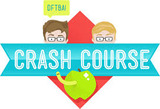
CrashCourse offers many YouTube videos that support various historical topics, such as sociology, world history, and much more!
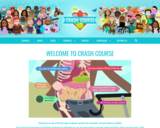
You can learn pretty much anything with these videos!
Science, History, Language Arts, & Study Skills, Games & More!

This new website from Agriculture in the Classroom is a kid-friendly, engaging website that will bring the story of agriculture to life through highly interactive information, colourful illustrations, real-life photos, informative text, quizzes, teacher lessons and more! Students will discover the Past, Present, Evolution and Future of agriculture in Saskatchewan.

This comprehensive website contains a great deal of information and there are many curricular connections to grades 3 – 6 Science, Social Studies, and English Language Arts.
Be sure to check out the "Past", "Evolution", "Present" and "Future" tabs along the top to access LOTS of great ag resources and information!
Among other things, the site offers:
- Simple Lessons - Depending on the sections your students study and activities undertaken, different outcomes may be met. There are several ‘grab and go’ activities for students, available in both pdf and word documents.
- Brain Buster Activities - These crossword puzzles, word searches, word scrambles, matching pages, and colouring pages are great when time is limited because they can be easily stopped and started! They will challenge students to problem-solve and test their knowledge.
- Quizzes - The quizzes here are generally the same quizzes as the students will find on the web pages. They are available for each section on this website so that students progress can be tracked if you wish!

Find a ton of pre-recorded virtual events from Flipgrid to use with your class.
There is something here for every age group, and every subject!
Enjoy exploring.
Find future Flipgrid events here (copy and paste into a browser) https://blog.flipgrid.com/upcomingflipgridliveevents

This is a year plan created using GAP resources that any teacher can take and use. This is intended for teachers new to teaching Grade Six, but can be used by any Grade Six teacher to offer ideas of what can be used to teach the content of the Grade Six curriculum.

The new website for the Heritage Fairs (& High School Heritage Challenge) is now live and ready to accept project submissions for the Virtual Heritage Fair (grades 4-8) and the High School Heritage Challenge (grades 9-12)!
The Heritage Fair program provides the opportunity for students and their families, teachers and communities to learn about diverse Living Heritage projects.
There is still lots of time to prepare and submit a project to these contests, as the deadline is Monday, April 24. The online contests are open to all students in Saskatchewan.
Links to register and submit projects are on the homepage, as well as available in the dropdown menus for each respective contest.
Be sure to check out the Heritage Fairs toolkit that will give you topic inspiration, a list of popular research sources, and a detailed breakdown on how to create your presentation and share your findings. The toolkit is available in both English and French.
Le nouveau site web des Fêtes du patrimoine (et du Défi du patrimoine au secondaire) est maintenant en ligne et prêt à accepter les soumissions de projets pour la Fête du patrimoine virtuelle (niveaux 4 à 8) et le Défi du patrimoine au secondaire (niveaux 9 à 12) !
Le programme des Fêtes du patrimoine offre l'occasion aux élèves et à leurs familles, aux enseignants et aux communautés d'en apprendre davantage sur divers projets de patrimoine vivant.
Il reste encore beaucoup de temps pour préparer et soumettre un projet à ces concours, car la date limite est le lundi 24 avril. Les concours en ligne sont ouverts à tous les élèves en Saskatchewan.
Les liens pour s'inscrire et soumettre des projets se trouvent sur la page d'accueil, ainsi que dans les menus déroulants de chaque concours respectif.
Assurez-vous de consulter la trousse des Fêtes du patrimoine qui vous fournira de l'inspiration pour votre sujet, une liste de sources de recherche populaires et une description détaillée sur la création de votre présentation et le partage de vos résultats. La trousse est disponible en anglais et en français.
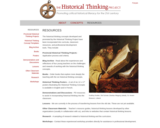
The historical thinking concepts developed and promoted by the Historical Thinking Project have been incorporated into curricula, classroom resources, and professional development tools. They include:
Provincial Historical Thinking Projects - Application process and criteria.
Blog Archive - Read about the experiences and reflections of four young teachers on the challenges and rewards of working with the historical thinking concepts.
Books - Order books that explore more deeply the teaching with the six historical thinking concepts.
Historical Thinking Posters – A set of six 12 x 17" posters illustrating the Historical Thinking Concepts is available in English and in French.
Demonstrations and Discussions - PD resources to assist in incorporating historical thinking into the classroom.
Lessons - We are currently in the process of transferring lessons from the old site. These are not yet available.
Other Classroom Materials - Teacher’s resource guides, historical thinking lessons developed by other organizations (usually in collaboration with us), and links to websites that contain historical thinking lessons.
Research - A sampling of research related to historical thinking and the curriculum.
Workshops - Contact these experienced workshop providers directly for assistance in professional development.
Use of Materials/Copyright
We encourage the use of resources, lessons, and information from our site, but we ask that you credit the Historical Thinking Project for the ideas and materials, by listing our name and our website URL (www.historicalthinking.ca). Fair use of resources does NOT include posting of HTP power points, videos, or other resources on other sites. Use a link to www.historicalthinking.ca instead.
We want historical thinking incorporated into curriculum, classrooms, and educational resources as widely as possible. When you reference the Historical Thinking Project (www.historicalthinking.ca) you are helping us to achieve this goal.

Have you ever wondered what it would be like to live in an igloo?It would be pretty cold compared to the houses we live in now. Could you imagine living with over forty other people in one big house? Living with that many people would be like sharing a house with your whole class and all the teachers in your school!
The environment that we live in affects everything that we do. Canada is a country with a lot of different environments. There are parts of Canada where the temperature is freezing and all you can see is snow for most of the year. There are places where it rains a lot of the time and places where it is very dry. There are places that have mountains and some that are flat. There are rivers, lakes and oceans. Canada has a very diverse landscape.
In the past, First Nations were the only people living in Canada.They are the First Nations because they were the first occupants of North America. In Canada, each First Nation had to adapt to their environment in different ways. The houses they built, the food they ate, and the activities they did were all greatly affected by the environment they lived in.
Here you can look at three different aboriginal cultures from three different parts of Canada: the Huron, the Haida, and the Inuit. You can compare them to see how different their ways of life were because of where they lived.
Teaching resources available.
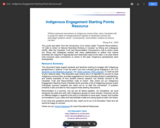
This document helps support students and teachers wishing to engage with Indigenous perspectives in science. It also covers why it is important to connect to local Indigenous communities, provides suggestions on how to develop student understanding, and shares examples of how student science research can directly connect to the
Canadian Truth and Reconciliation Calls to Action.
Also check out the Indigenous Engagement Starting Points Checklist which provides a list of Indigenous groups and/or individuals you/your students can reach out to, to start this connection. A question checklist is also provided to help support those starting discussions.

Indigenous games for children.

Indigenous people have long passed on knowledge from generation to generation through oral traditions, including storytelling. Storytelling teaches history, values, beliefs and ways of life.
Enjoy this series of oral stories told by Elder Hazel, where you'll hear all kinds of fascinating stories.

Journey 2050 allows schools around the world to experience agriculture like it has never been taught before. As students explore world food sustainability, they make inquiry-based decisions to see the ripple effect on social, economic and environmental factors locally and globally. Agricultural experts and real farm families from Kenya, India and Canada guide students through a virtual farm simulation, avatar career game and geography scavenger hunt.